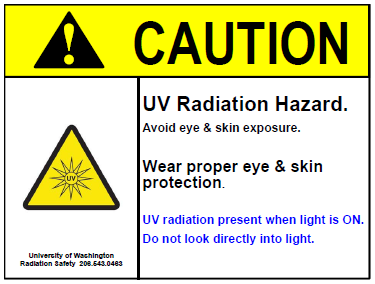Does your biological safety cabinet (BSC) have an ultraviolet (UV) lamp in it? If so, it may not be as effective for sterilization/decontamination purposes as you need it to be.
Ultraviolet radiation is a form of non-ionizing radiation, and biological effects from it vary with wavelength, photon energy, and duration of exposure. The 100-280 nm wavelength band is designated as UV-C, which is used for germicidal purposes.
The sterilization/decontamination activity of UV lights is limited by a number of factors, including:
- Penetration – In the dynamic air streams of BSCs, microorganisms beneath dust particles, plastics, and work surfaces are not affected by the UV light because it cannot penetrate particles so far from the UV source.
- Relative humidity – The germicidal effects of UV light drop off precipitously when relative humidity is above 70%.
- Temperature and air movement – The optimum temperature for the UV lamp to be effective is 77-80 degrees F. Temperatures below this range result in reduced efficacy, and air movement can exacerbate this.
- Cleanliness – Dust and dirt block the germicidal effectiveness of the UV lamp, so weekly cleanings are necessary.
- Age – Check UV lamps every six months to assure proper function, as the amount of germicidal wavelength emitted decreases with bulb age and hours of use.
- Overuse – UV lights are routinely left on overnight or longer in an effort to decontaminate workspaces, but this practice can result in the germicidal wavelength no longer being produced by the bulb.
For these reasons and other concerns, the National Sanitation Foundation (NSF) does not recommend the use of UV lights in BSCs. Retrofitting any equipment (e.g., UV lights) into a cabinet may alter the air flow characteristics, invalidate the manufacturer warranty, and is not recommended. Be aware that EH&S does not support the use of UV lights in BSCs. Laboratories are solely responsible for maintaining any UV lights in their cabinets, and will need to use outside contractors for servicing.
If you are using a UV light, please be advised:
- No one should be present in a room where a UV light is on, due to the short time for UV overexposure to occur. Less than one minute of direct exposure can result in severe eye damage and additional health effects including skin cancer. Refer to the EH&S UV Safety Sheet for further information.
- BSCs with UV lamps should be labeled with a UV Light Source Caution sticker. Contact radsaf@uw.edu to get a sticker for your cabinet.
- For assistance with disposing of UV bulbs and lamps, go to the UW Facilities Disposal Guide website.